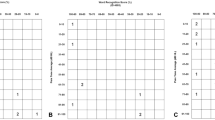Abstract
The aim of this study was to evaluate the cochlear implant (CI) performances in neurofibromatosis type 2 (NF2) patients with bilateral vestibular schwannoma (VS) and in patients with sporadic VS in the only or better hearing ear. All patients with bilateral VS or sporadic VS in the only or better hearing ear who underwent cochlear implantation, either simultaneous to VS surgery or staged after treatment for VS, in the tumor side were chosen for the study. Postimplantation audiometric scores (sound detection, closed-set and open-set discrimination scores) and device use patterns were the main outcome measures. 15 patients were implanted. Eight patients (53 %) were NF2 and seven patients had VS in the only or better hearing ear. One patient was explanted for cerebrospinal fluid leak. In the CI-only condition, the other 14 patients obtained sound detection, 64 % of them achieving open-set discrimination (mean 70 ± 38 %) and 85 % achieving closed-set discrimination (mean 41 ± 33 %). At the last follow-up 10 patients (67 %) were using the CI. Cochlear implantation provides hearing in particular cases of patients with bilateral VS or VS in the only or better hearing ear. As long as anatomic preservation of the cochlear nerve is achieved, cochlear implantation may offer improvement in communication skills for most patients.

Similar content being viewed by others
References
Merkus P, Di Lella F, Di Trapani G, Pasanisi E, Beltrame MA, Zanetti D, Negri M, Sanna M (2014) Indications and contraindications of auditory brainstem implants: systematic review and illustrative cases. Eur Arch Otorhinolaryngol 271:3–13
Schwartz MS, Otto SR, Shannon RV, Hitselberger WE, Brackmann DE (2008) Auditory brainstem implants. Neurotherapeutics 5:128–136
Hoffman RA, Kohan D, Cohen NL (1992) Cochlear implants in the management of bilateral acoustic neuromas. Am J Otol 13:525–528
Carlson ML, Breen JT, Driscoll CL, Link MJ, Neff BA, Gifford RH, Beatty CW (2012) Cochlear implantation in patients with neurofibromatosis type 2: variables affecting auditory performance. Otol Neurotol 33:853–862
Mukherjee P, Ramsden JD, Donnelly N, Axon P, Saeed S, Fagan P, Irving RM (2013) Cochlear implants to treat deafness caused by vestibular schwannomas. Otol Neurotol 34:1291–1298
Di Lella F, Merkus P, Di Trapani G, Taibah A, Guida M, Sanna M (2013) Vestibular schwannoma in the only hearing ear: role of cochlear implants. Ann Otol Rhinol Laryngol 122:91–99
Celis-Aguilar E, Lassaletta L, Gavilan J (2012) Cochlear implantation in patients with neurofibromatosis type 2 and patients with vestibular schwannoma in the only hearing ear. Int J Otolaryngol 2012:157497
The 1995 guidelines of the American Academy of Otolaryngology—head and neck surgery (AAOHNS)
Cueva RA, Thedinger BA, Harris JP, Glasscock ME 3rd (1992) Electrical promontory stimulation in patients with intact cochlear nerve and anacusis following acoustic neuroma surgery. Laryngoscope 102:1220–1224
Aristegui M, Denia A (2005) Simultaneous cochlear implantation and translabyrinthine removal of vestibular schwannoma in an only hearing ear: report of two cases (neurofibromatosis type 2 and unilateral vestibular schwannoma). Otol Neurotol 26:205–210
Neff BA, Wiet RM, Lasak JM, Cohen NL, Pillsbury HC, Ramsden RT, Welling DB (2007) Cochlear implantation in the neurofibromatosis type 2 patient: long-term follow-up. Laryngoscope 117:1069–1072
Tran Ba Huy P, Kania R, Frachet B, Poncet C, Legac MS (2009) Auditory rehabilitation with cochlear implantation in patients with neurofibromatosis type 2. Acta Otolaryngol 129:971–975
Vincenti V, Pasanisi E, Guida M, Di Trapani G, Sanna M (2008) Hearing rehabilitation in neurofibromatosis type 2 patients: cochlear versus auditory brainstem implantation. Audiol Neurootol 13:273–280
Lustig LR, Yeagle J, Driscoll CL, Blevins N, Francis H, Niparko JK (2006) Cochlear implantation in patients with neurofibromatosis type 2 and bilateral vestibular schwannoma. Otol Neurotol 27:512–518
Roehm PC, Mallen-St Clair J, Jethanamest D, Golfinos JG, Shapiro W, Waltzman S, Roland JT Jr (2011) Auditory rehabilitation of patients with neurofibromatosis type 2 by using cochlear implants. J Neurosurg 115:827–834
Lloyd SK, Glynn FJ, Rutherford SA, King AT, Mawman DJ, O’Driscoll MP, Evans DG, Ramsden RT, Freeman SR (2014) Ipsilateral cochlear implantation after cochlear nerve preserving vestibular schwannoma surgery in patients with neurofibromatosis type 2. Otol Neurotol 35:43–51
Tysome JR, Axon PR, Donnelly NP, Evans DG, Ferner RE, O’Connor AF, Freeman SR, Gleeson M, Halliday D, Harris F, Jiang D, Kerr R, King A, Knight RD, Lloyd SK, Macfarlane R, Mannion R, Mawman D, O’Driscoll M, Parry A, Ramsden J, Ramsden R, Rutherford SA, Saeed SR, Thomas N, Vanat ZH (2013) English consensus protocol evaluating candidacy for auditory brainstem and cochlear implantation in neurofibromatosis type 2. Otol Neurotol 34:1743–1747
Wackym PA, Runge-Samuelson CL, Nash JJ, Poetker DM, Albano K, Bovi J, Michel MA, Friedland DR, Zhu YR, Hannley MT (2010) Gamma knife surgery of vestibular schwannomas: volumetric dosimetry correlations to hearing loss suggest stria vascularis devascularization as the mechanism of early hearing loss. Otol Neurotol 31:1480–1487
Trotter MI, Briggs RJ (2010) Cochlear implantation in neurofibromatosis type 2 after radiation therapy. Otol Neurotol 31:216–219
Siegbahn M, Lundin K, Olsson GB, Stillesjo F, Kinnefors A, Rask-Andersen H, Nyberg G (2014) Auditory brainstem implants (ABIs)—20 years of clinical experience in Uppsala, Sweden. Acta Otolaryngol 134:1052–1061
Grayeli AB, Kalamarides M, Bouccara D, Ambert-Dahan E, Sterkers O (2008) Auditory brainstem implant in neurofibromatosis type 2 and non-neurofibromatosis type 2 patients. Otol Neurotol 29:1140–1146
Crane BT, Gottschalk B, Kraut M, Aygun N, Niparko JK (2010) Magnetic resonance imaging at 1.5 T after cochlear implantation. Otol Neurotol 31:1215–1220
Walton J, Donnelly NP, Tam YC, Joubert I, Durie-Gair J, Jackson C, Mannion RA, Tysome JR, Axon PR, Scoffings DJ (2014) MRI without magnet removal in neurofibromatosis type 2 patients with cochlear and auditory brainstem implants. Otol Neurotol 35:821–825
Conflict of interest
The authors declare that there is no conflict of interests regarding the publication of this paper.
Author information
Authors and Affiliations
Corresponding author
Rights and permissions
About this article
Cite this article
Lassaletta, L., Aristegui, M., Medina, M. et al. Ipsilateral cochlear implantation in patients with sporadic vestibular schwannoma in the only or best hearing ear and in patients with NF2. Eur Arch Otorhinolaryngol 273, 27–35 (2016). https://doi.org/10.1007/s00405-014-3450-3
Received:
Accepted:
Published:
Issue Date:
DOI: https://doi.org/10.1007/s00405-014-3450-3




